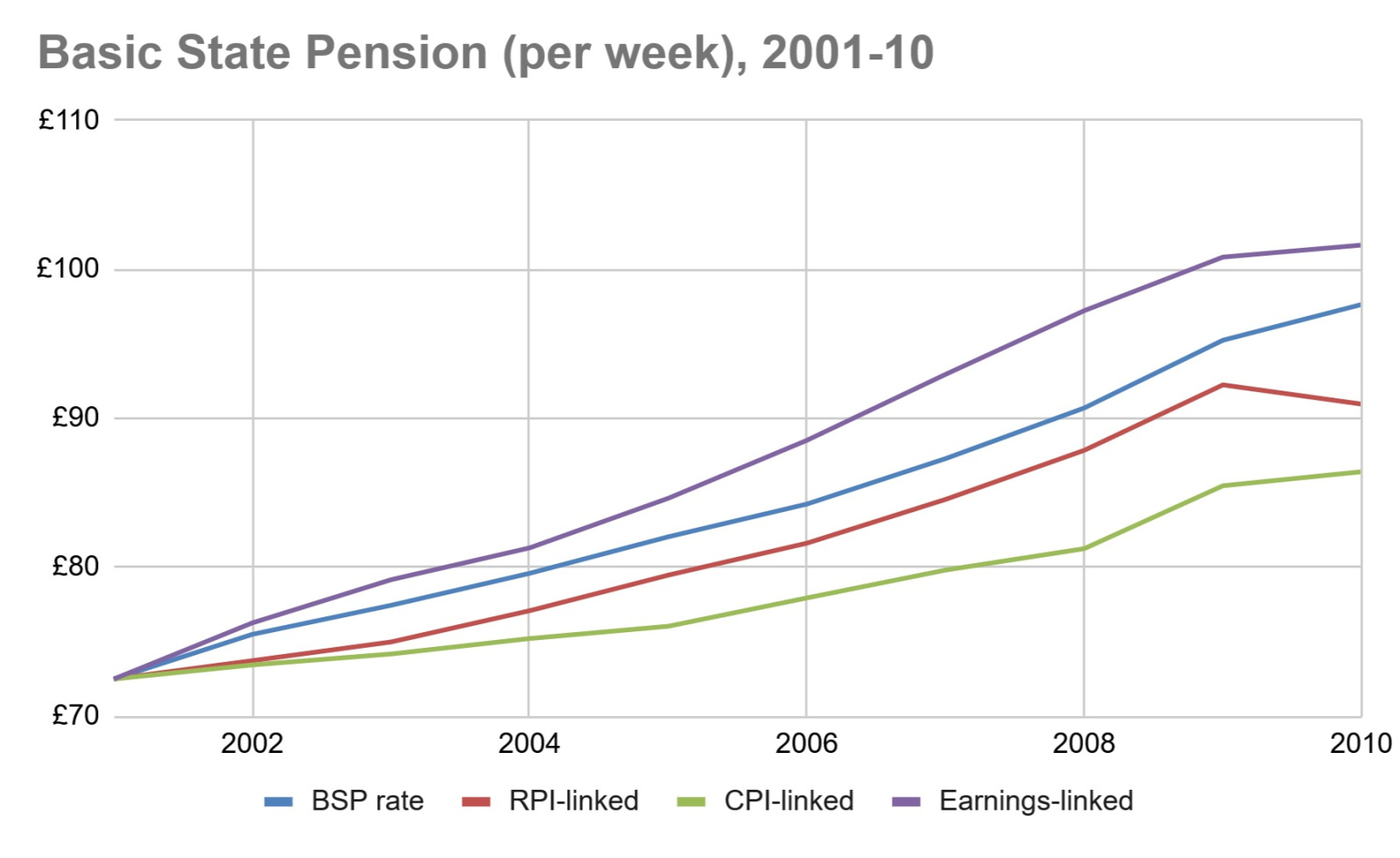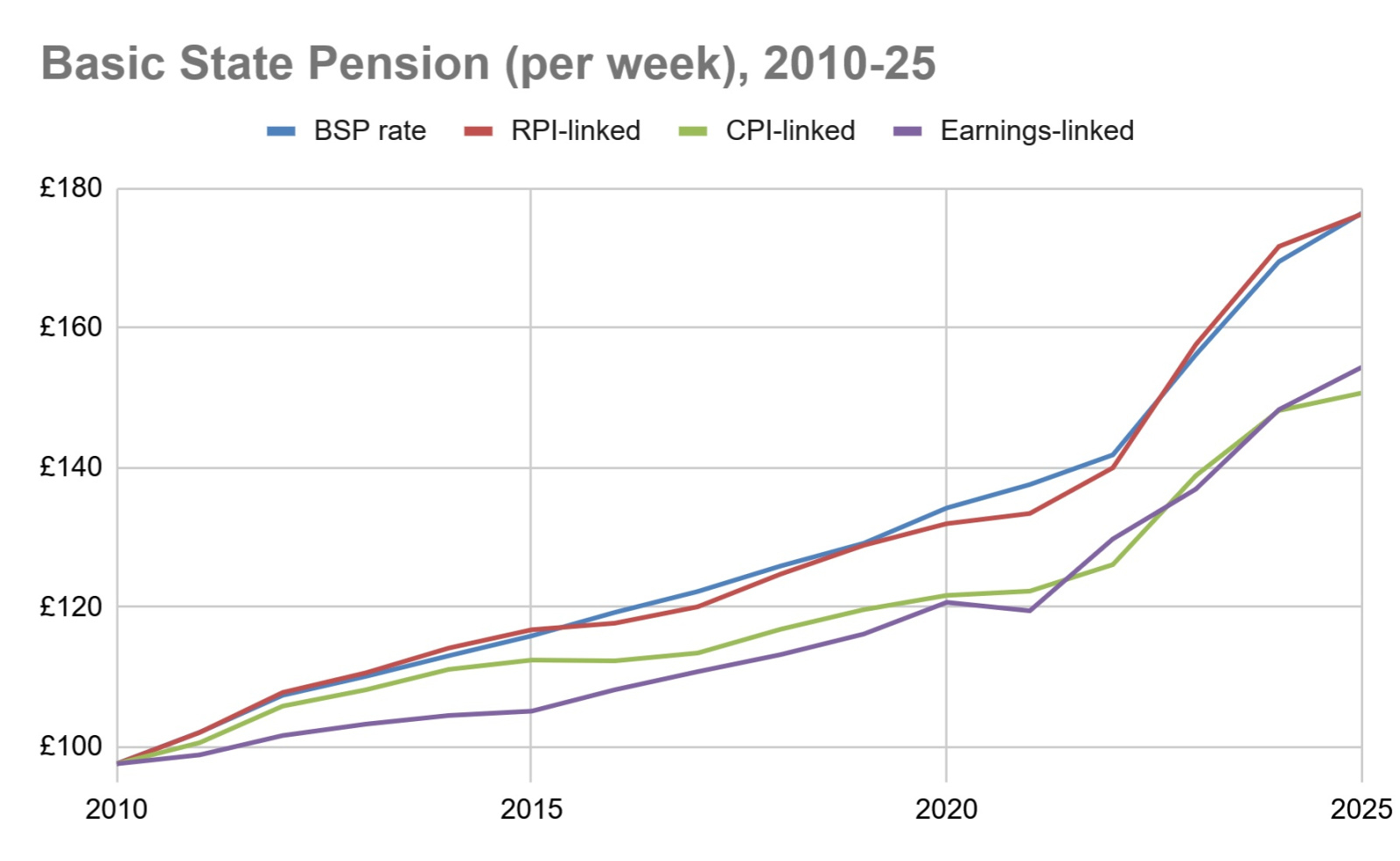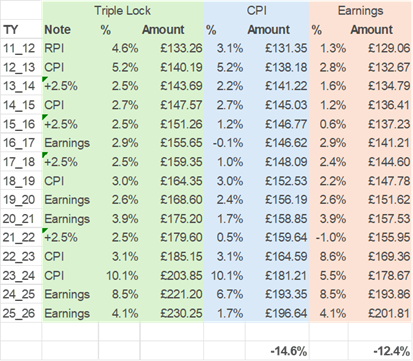We’d like to remind Forumites to please avoid political debate on the Forum.
This is to keep it a safe and useful space for MoneySaving discussions. Threads that are – or become – political in nature may be removed in line with the Forum’s rules. Thank you for your understanding.
📨 Have you signed up to the Forum's new Email Digest yet? Get a selection of trending threads sent straight to your inbox daily, weekly or monthly!
Gov launching pension age review
Comments
-
Exodi said:
I don't even know how you could conclude that increasing income tax on working families is the 'simplest' answer?Stubod said:However I guess the bottom line is that it is unafordabe and getting ever more so. Not sure why they don't simply increase income taxMove employee NI over to being IT instead. An IT increase that "working families" won't even notice.Base SP qualification on IT paid instead.
N. Hampshire, he/him. Octopus Intelligent Go elec & Tracker gas / Vodafone BB / iD mobile. Ripple Kirk Hill Coop member.Ofgem cap table, Ofgem cap explainer. Economy 7 cap explainer. Gas vs E7 vs peak elec heating costs, Best kettle!
2.72kWp PV facing SSW installed Jan 2012. 11 x 247w panels, 3.6kw inverter. 34 MWh generated, long-term average 2.6 Os.1 -
..would be interested to see the "real value" of the SP over time, and compare how much it has changed (up or down) over the last 50 yers or so taking into account rpi. Have had a google, but can't find anything..."It's everybody's fault but mine...."0
-
The modern UK State pension dates from 1948, being part of Beveridge's post war welfare state reforms. The aim of the State pension was just to provide a universal safety net against poverty in old age. Beveridge himself stressed that the pension was only the bare minimum needed, and that anyone who wanted more would have to provide that for themselves.Stubod said:..would be interested to see the "real value" of the SP over time, and compare how much it has changed (up or down) over the last 50 yers or so taking into account rpi. Have had a google, but can't find anything.
Back in 1948 the weekly pension rates were:
Single person £1.30
Married couple £2.10
There are various means of uplifting these figures to present day, but I've used the public sector pensions increase tables (RPI to 2010 then CPI to date), giving us:
£1.30 X 44.2248 = £57.49
£2.10 X 44.2249 = £92.87
Later, it became possible to increase the State pension by means of salary related Graduated Pension (1961 to 1975) and SERPS/SP2 (1978 to 2016).
ADD
A cost of living/inflation calculator reckons:
£1.30 = £68.77
£2.10 = £111.09
A bit better, but still nowhere near today's pensions. Not even just the old basic State pension.
6 -
Exodi said:
I'm not sure how you can arrive at a conclusion like that with a single data point, without any substance like the tax bands, NI, etc.SouthCoastBoy said:From memory I think income tax was 30% when I started work, so as young adults we were paying a lot higher income tax than now.Depending on exactly when you got your first job, income tax was over 30% for several years in the 1970'sHistoric NICs rates are more difficult to find, but there is this:Personal AllowancesNot easy to compare, particularly with the additional "married man's allowance" and allowances for children which not everyone qualified for.But my memory is also that, as a single person, starting work in the 1970's meant around 1/3 of my gross wages disappeared before I got them.
1 -
Here is a chart of what the Basic State Pension would be if it had been increased since 2001 by various indices. Basic State Pension is used for consistency throughout the whole period, and 2001 is chosen as that is the start date of the earnings index.
 Over the last 24 years, Basic State Pension has increased at a faster rate than any of earnings, RPI or CPI. However, looking at the full period masks some interesting differences.
Over the last 24 years, Basic State Pension has increased at a faster rate than any of earnings, RPI or CPI. However, looking at the full period masks some interesting differences. During the period 2001-10, State Pension didn't quite keep pace with earnings, but increased faster than either RPI or CPI.
During the period 2001-10, State Pension didn't quite keep pace with earnings, but increased faster than either RPI or CPI. Since 2010, recalling the Triple Lock was introduced in 2011, State Pension has increased at a rate almost identical to RPI, but much faster than either earnings or CPI.It is interesting to recall that from the early 1980s to the late 1990s State Pension was indexed to RPI. During that period, it was widely agreed that the value was eroded (as it declined relative to earnings). The last 15 years have been extremely similar to RPI, so for the period 1980-2025 the increase has been very close to RPI, except for the higher than RPI period between 2001-10.4
Since 2010, recalling the Triple Lock was introduced in 2011, State Pension has increased at a rate almost identical to RPI, but much faster than either earnings or CPI.It is interesting to recall that from the early 1980s to the late 1990s State Pension was indexed to RPI. During that period, it was widely agreed that the value was eroded (as it declined relative to earnings). The last 15 years have been extremely similar to RPI, so for the period 1980-2025 the increase has been very close to RPI, except for the higher than RPI period between 2001-10.4 -
Plagiarise ? This is a discussion board, and I'm commenting on your post ( which, as I said up front, I thought was interesting ).Exodi said:
At least add value when you plagiarise.af1963 said:
That table is interesting. The year-by-year increases, based on the highest of the three figures in each year individually, produces a pension of £230.25. Linking it to whichever of CPI or Earnings or 2.5%pa had increased most since the base year, *cumulatively*, would have produced £201.80, based on the link to wages, about 15% less. (The CPI link would have been used until 2022-3 when wages finally overtook CPI for the first time during the period, then again in 2023-4 when wages fell behind inflation again.)
Earnings weren't used to uprate the state pension in 22_23 because they were seen as artificially inflated due to fluctuating earnings caused by pandemic measures like furlough.
https://commonslibrary.parliament.uk/research-briefings/cbp-9439/#:~:text=Pension rates in 2022/23,£179.60 in 2021/22.
My point, which I don't think was in your original, is that a triple lock that worked cumulatively since 2011 rather than each year individually, would still protect pensioners from inflation and keep them in line with wages, but would have risen a good bit less, and might be a way to keep some sort of lock for the future without the same 'ratchet' effect that causes the pension to rise as a share of wages.
Had they been doing it that way, freak pairs of years like 21-22 and 22-23 also wouldn't have the same potential impact and may not have required special treatment.0 -
The difference being that in the 80s and 90s, an RPI link was less than the rest of society was getting - living standards generally were rising but state pensioners didn't share this - whereas 2010-25 it was better than people of working age were receiving, since general living standards were below 2011 in real terms for most of this period. (and still are, if you compare against RPI rather then CPI)hugheskevi said:It is interesting to recall that from the early 1980s to the late 1990s State Pension was indexed to RPI. During that period, it was widely agreed that the value was eroded (as it declined relative to earnings). The last 15 years have been extremely similar to RPI, so for the period 1980-2025 the increase has been very close to RPI, except for the higher than RPI period between 2001-10.0 -
I found those tables the other day when I was pondering the whole "we're taxed more than ever" claims that are banded around.LHW99 said:Exodi said:
I'm not sure how you can arrive at a conclusion like that with a single data point, without any substance like the tax bands, NI, etc.SouthCoastBoy said:From memory I think income tax was 30% when I started work, so as young adults we were paying a lot higher income tax than now.Depending on exactly when you got your first job, income tax was over 30% for several years in the 1970'sHistoric NICs rates are more difficult to find, but there is this:Personal AllowancesNot easy to compare, particularly with the additional "married man's allowance" and allowances for children which not everyone qualified for.But my memory is also that, as a single person, starting work in the 1970's meant around 1/3 of my gross wages disappeared before I got them.
I remember what my 1990 salary was (finished training and qualified) and I remember that my takehome after personal allowance was 2/3 of my gross between tax and NI. So unless you are adding in VAT, Insurance Premium Tax, VAT on energy bills (there didn't used to be any) and any other indirect taxes then I think it's a spurious claim, as these days I take home 75% of my gross salary and have a degree of control over how much indirect tax I pay.......Gettin' There, Wherever There is......
I have a dodgy "i" key, so ignore spelling errors due to "i" issues, ...I blame Apple 0
0 -
Ah, but there was no Netflix, Starbucks, or fancy foreign holidays back then. People grew their own veg, and there wasn't the same socialisng culture (well, maybe the odd bottle of parsnip wine with Fred and Ethel at Number 23).Silvertabby said:
The modern UK State pension dates from 1948, being part of Beveridge's post war welfare state reforms. The aim of the State pension was just to provide a universal safety net against poverty in old age. Beveridge himself stressed that the pension was only the bare minimum needed, and that anyone who wanted more would have to provide that for themselves.Stubod said:..would be interested to see the "real value" of the SP over time, and compare how much it has changed (up or down) over the last 50 yers or so taking into account rpi. Have had a google, but can't find anything.
Back in 1948 the weekly pension rates were:
Single person £1.30
Married couple £2.10
There are various means of uplifting these figures to present day, but I've used the public sector pensions increase tables (RPI to 2010 then CPI to date), giving us:
£1.30 X 44.2248 = £57.49
£2.10 X 44.2249 = £92.87
Later, it became possible to increase the State pension by means of salary related Graduated Pension (1961 to 1975) and SERPS/SP2 (1978 to 2016).
ADD
A cost of living/inflation calculator reckons:
£1.30 = £68.77
£2.10 = £111.09
A bit better, but still nowhere near today's pensions. Not even just the old basic State pension.
Even accounting for inflation, it was a simpler more austere life. And sweets were still rationed in 1948!1 -
Given wages pay the state pension I don’t see how it is sustainable for pensions to keep increasing at a rate higher than wages. Not if you want workers to have families, homes, and grandkids.hugheskevi said:Since 2010, recalling the Triple Lock was introduced in 2011, State Pension has increased at a rate almost identical to RPI, but much faster than either earnings or CPI..1
This discussion has been closed.
Confirm your email address to Create Threads and Reply

Categories
- All Categories
- 352.4K Banking & Borrowing
- 253.7K Reduce Debt & Boost Income
- 454.4K Spending & Discounts
- 245.4K Work, Benefits & Business
- 601.3K Mortgages, Homes & Bills
- 177.6K Life & Family
- 259.3K Travel & Transport
- 1.5M Hobbies & Leisure
- 16K Discuss & Feedback
- 37.7K Read-Only Boards







